

|
Home Updates Hydros Cars Engines Contacts Links Contact On The Wire |
Pitbox Specials

Boxotrix
Sometimes identification can be something of a doddle, especially when the vintage hydroplane in question has its name down the side and was described in detail in Model Engineer and later in Model Boats.
|
|
The mystery is where it has been since 1955? The original enquiry came via a roundabout route through Model Boats and Jim Free from the owner who had purchased the boat at an auction in Cornwall. Jim immediately recognised the boat and passed on the pictures to us in order to add any material we might have. It all gets a bit surreal at this point as the boat had already featured on the site in our early days, but as there was no further information or original photos of it, we took the article off during a ‘spring clean’. |
|
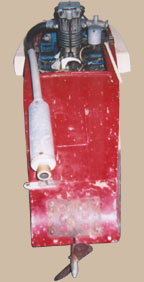 |
E.A. Walker of South London and later the Kingsmere Club was well known for his 1930s boat ‘Gilda’ (originally ‘Pep’), but as he describes. "Some friendly leg-pulling at the club, coupled with the fact that other members’ speeds were beating mine by an ever increasing margin made me decide to pension off my pre-war hydroplane Gilda."
In October 1955 in the Model Engineer, he described how he had built the 30cc ‘A’ Class ‘Boxotrix’ and all the work that had gone into producing a new engine for it. The boat and engine is a wonderful amalgamation of design features from the 30s and late 40s, obviously influenced by fellow club member Edgar Westbury. 1955 also seemed to be the last year that Mr Walker competed, and so ‘Boxotrix’ was consigned to history.
From 1985 onwards, Model Boat published an occasional series of articles by R.T. Pole, the respected sage of tethered hydroplane history, entitled ‘Historic Hydros’. Number 2 in the series was Mr Walker’s ‘Gilda’, with ‘Boxotrix’ being featured later. Thanks to the generosity of R.T. Pole, who we are happy to say is returning to peak form after a few set-backs, the full article is reproduced below.
Update Jan 2020: Peter Cullum's collection was sold at Truro this month, bought by a toy dealer for £550, Boxotrix appeared at the end of the month on eBay for £2950. Not bad when it was bought a few years earlier for less than £40?
Historic Hydros
|
|
Boxotrix, although never a record breaker was the last 30cc hydro hull design published by the Model Engineer, and dates from 1955, and was capable of over 50mph according to the heading of the article. When one realises that the then currant A class record was at least 20mph faster at this time it confirms the rather outdated thinking of the then editorial staff on modern developments. |
This possibly explains the disappearance by 1961 of any hydro information and the folding of the ME Speedboat competition a couple of years earlier. Rather a shame when one looks at the long period of time that first speedboat, and then hydros were covered by the magazine.
Boxotrix’s builder was Mr E.A. Walker who’s previous boat had been called Gilda. It was from this craft that the engine was taken for Boxotrix. The original engine was a Bond’s Simplex crankcase and bottom end mated to a Grayson top half and dated in concept from the early 1930’s, so further development was certainly required. This commenced with the making of a new cylinder head with inclined valves in aluminium with aluminium bronze valve seating inserts. The valves were turned down from Austin 7 car items and fitted with twin springs. The change to the head meant that a new cylinder and piston were also required and these were made from cast iron with a shrunk on aluminium jacket. The new piston was cast from car piston alloy and fitted with a pair of Wellworthy rings, the piston itself was of the Slipper type.
 |
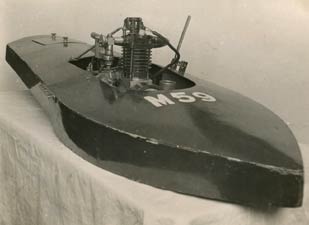 |
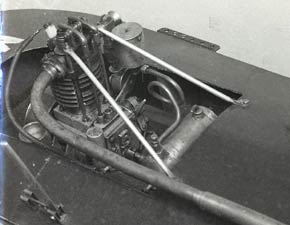 |
| Mr Walker with earlier Nipalong | Gilda | Gilda and Boxotrix motor |
At this point in the story the engine was test run in the old boat and following modifications to the carburettor a speed of 40mph was obtained, 4 mph faster than the old engine. However, due to the extra strain on the bottom end, first backlash developed in the skew gears and then the crankpin sheared off the web.
The decision was made to rebuild the entire bottom end. The crankshaft was constructed from a Bond’s forging and a new crankcase with press fitted ballraces designed. A gravity oil feed system was tried at this stage but found to be wanting, so an orthodox spring loaded pump was made and fitted. By this time it was thought that a new camshaft would be required, and was made from nickel chrome R.E.805 steel, case hardened. A new conrod was also required and was of dural with a phosphor bronze big end. Following this rebuild, the engine timing was as follows; inlet opens 25 degrees B.T.D.C, closes 65 degrees A.B.D.C; exhaust valve opens 70 degrees B.B.D.C and 30 degrees A.T.D.C.
The original flywheel was retained but considerably lightened. As can be seen by the amount of work that Mr Walker went through in tuning up his existing engine, it was virtually little less than starting with a clean sheet and designing a completely new motor.
The ignition was by coil and battery and the silencer and exhaust system was similar to a Burgess one, being fabricated from alloy tube, perforated steel sheet and packed with glass wool.
|
The hull was of very lightweight construction and simple in the extreme. The sides, floor and decking were from 1/16th in. plywood with ¼ in. square beech for runners. The bulkheads were also 1/16th in. ply with the ¼ in. square beech glued to the edges. For the engine bearers ¾ in. thick mahogany was used and these ran the whole length of the hull, later reinforced by bent–up sheet steel plates in the engine bay due to structural failure of the mahogany. The plates were bolted through the hull sides and bottom. The sponsons were from solid balsa and attached onto the hull with 3/8 in. diameter wooden dowelling, which passed right through the boat. The rear skeg was slotted into the centre on the transom with a curved clamping plate to allow adjustment of the thrust line. Casco glue was used throughout the hull with the ply to beech being reinforced by bent over pins. |
|
Following tests at Beddington Park in South London, Mr Walker entered Boxotrix at the Blackheath regatta and reached just under 50mph until a carb fault slowed the boat up. The Bedford regatta saw a speed of 50mph achieved, but this was not fast enough to get into the places and various problems due to ignition failure occurred over the next few competitions. However, these were sorted out and a speed of 53.8mph was recorded at the Kingsmere regatta Wimbledon. Whether Mr. Walker continued racing Boxotrix after the 1955 season I do not know as his name does not appear in any regatta result list.
In conclusion not an exciting design but one which would carry any 30cc four stroke or two stroke engine of limited power quite safely round the pole.
So, that was ‘Boxotrix’, capable of over 50mph, but a boat and motor ‘out of its time’. Even with the benefit of a three-point hull and surface prop it was still slower than the likes of Betty, Faro and Bulrush that had been built in the mid 30s. Not only was it significantly slower that most of the other ‘A’ Class boats, it was also dogged with vibration, as the ME article points out. Clear to see in the photographs are the extra steel engine plates fitted to try and stop the motor shaking itself out of the boat. Also there are two ‘head steadies’ that go from the cylinder head to the hull that must have been added after the photos in Model Engineer were taken.
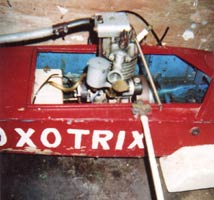 |
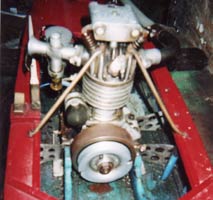 |
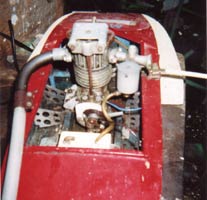 |
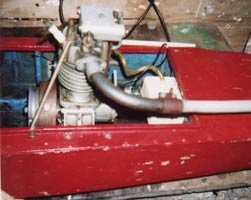 |
When the boat was last seen it had a Kingsmere registration, but by the time it turned up at the auction in Cornwall, it had gained the Medway Club number. It also seems to have acquired a new paint finish and name on one side only. A gentle probing of the flaking paint reveals a blue colour underneath, which may well be original. The blue inside is probably not, as this is the same colour as the new registration.
|
Tucked in the hull was a photograph of the original motor, giving some idea of how it morphed from a Bond’s Simplex/Grayson hybrid to a Westbury Kittiwake Major based design. Somewhere along the line the boat has gained a Medway registration number and a slightly garish paint finish, but is otherwise complete, and given the material that exist about it, makes it a very intriguing discovery indeed. It will be interesting to discover how the fuel and ignition systems were arranged, as the fuel tank is well below float chamber level, which means that either the tank was pressurised in some way or a fuel pump is fitted to the engine or drive shaft. |
|
There were two schools of thought as to
which way the engine should be mounted, in part to give the correct rotation for
the prop, depending on whether the boat was rigged to run clockwise or
anticlockwise. This in turn was dictated by whether a surface or submerged prop
was being used. Here the engine is mounted with the very heavy flywheel to the
front and the drive from the timing side of the motor.
Thanks to Jim Free and Dave Wiggins for passing on the enquiry, to Peter Cullum for the contemporary photographs, Westbury family for early photos, to R.T. Pole for permission to use his article. Special thanks to Peter Hill for all the technical information.
©copyrightOTW2011
A ‘Lucky Find In Lincolnshire’
OTW has recently received photos of this vintage hydroplane previously featured in Pitbox. It has been possible to piece together some of the history of this fine looking boat although a great deal must still be conjecture. Mark is to be congratulated on the fine job he has made of cleaning and restoring this lovely example of an early tethered hydroplane.
|
|
The hull is a single step, metre long tethered racing design derived from the full sized racing boats of the period. The ‘boat shaped’ hull remained popular until the mid 30s when the scow or ‘kipper box’ became the norm. Dating from somewhere between 1929-34 it would seem that this hull was either professionally built or a commercial product, possibly from Grays of Clerkenwell. That it was a racing boat intended for tethered competition is borne out by the tether bracket to be seen on the right hand side of the hull and the remains of an ignition cut out (‘knock off’) on the left hand or ‘outside’ of the boat. |
|
At this stage one can only guess at the sequence of events, but it seems likely that the boat for whatever reason only had a short racing career before being converted for steering or straight running. Several clues lead to the conclusion that the original racing engine was taken out and this splendid water-cooled example installed in its place. The boat now has two fuel tanks, the original bolted to the rear of the engine compartment and a later one strategically placed for the down swept atmospheric carburettor on the engine. The original tank would have been pressurised from a bladder of some sort to feed a more conventional carb on the cylinder head of the original motor. |
|
|
|
The 25cc engine currently fitted is one of the best examples around of what was the most common of all engines of the period. The design is derived from the Economic Electric engine that was sold as a set of castings and in turn produced by Bond’s ‘O’ Euston Road as the first version of the Simplex, and by Grays of Clerkenwell as the Grayson. These engines were also sold by suppliers such as Gamages as an early example of badge engineering. With no identifying marks on the outside of the engine only a strip down would reveal its true origins. With the new engine being water-cooled and the boat running much more slowly than originally intended, a water pump has been connected to the prop shaft with a worm wheel arrangement. From the look of this fitting it would suggest that this is a much more recent addition and probably much later than the engine change. |
The large fins on the underside of the hull would have been added to give the boat a bit of directional stability as it lacks a rudder and would have been totally unpredictable as to its course. Even though the engine currently fitted is not exactly a racing motor a top speed of 25mph would not be impossible, although a trifle frightening if the boat was not tethered.
As can be seen from the photos, both the hull and engine are in lovely condition and the hull is certainly a very rare survivor from this era. If only OTW had not been going on holiday when it appeared on eBay!!!!
Many thanks to Mark Russell for supplying photo's, information and on going commentary on the restoration.
©copyright2006
'Vamp'
|
The discovery of a vintage hydroplane is always exciting, but unless there is some feature that can positively identify it, then origins, builder and past can only be guessed at. A name gives that extra level of anticipation, as there is always a chance that it will provide a key to unlocking the past of the particular boat. The delightful tradition of naming tethered cars and boats gave an identity to each that could usually be followed through magazine articles, results and photographs. While the cars became anonymous relatively quickly, it was not until the late 60s and early 70s that the bulk of boats lost their names. The name was to provide the key in this case.In 2007, Alan Thompson, Chairman of the South Shield Model Yacht Club, sent a set of photographs of a lovely vintage single step hydroplane called ‘Vamp’. From elements of the design of the hull and engine, it appeared to date from around the very early 1930s and the motor seemed to be a water-cooled version of one of the ‘Grayson’ variants. |
|
|
|
The known history of the boat then conspired to misdirect research until one of those ‘chance happenings’. On a recent visit to MPBA historian, Peter Hill, we were trawling through a sheaf of papers and amongst them was a photocopied picture of ‘Vamp’. Peter’s extensive knowledge and archives were to provide the identify of this superb boat. During the late 1920s and through the 30s the South London Experimental Power Boat Club, along with Victoria MSC was a hotbed for tethered hydroplane racing and development. Prominent members included Lionel French, Fred Ford, Harry Sharvell, Mr Oakley, a certain Edgar Westbury and a Mr Sharp. F.N. Sharp competed for many years, regularly featuring in results and the ME Speedboat Competition. His scow ‘Mona’ was the best known of his boats, both for its success in the ME competition and subsequent theft, along with its engine, but an earlier, less well known boat was none other than ‘Vamp’. Although a regular competitor, Sharp was better known for work with engines, with many of his fellow club members and numerous others around the country using motors built or inspired by him. |
|
In the late 1920s Sharp was building engines from castings provided by Economic Electric of Fitzroy Square London. In September 1930, Model Engineer published an article by him with a detailed description of how to build one of these 25cc OHV type B6a single cylinder four-strokes from the EE castings. To illustrate the article he used two of his boats, ‘Zulu’ with an air-cooled version of the motor, and ‘Vamp’ with the water-cooled variant. Also included are a number of trophies and prizes, presumably won by these two boats. This was the confirmation that the boat from South Shields was indeed the original ‘Vamp’ built by F.N. Sharp. |
|
|
|
The date of the article would infer that ‘Vamp’ was built around 1928/29 and the photos show that it has remained unchanged since then. It still has the water-cooled motor and even the ‘snubber’ on the bow. It seems likely that ‘Vamp’ would have been used primarily for straight course or steering events and ‘Zulu’ for ‘round the pole’, but until speeds became excessive, many boats were used for both events and certainly 'Vamp' has a tether plate just above the name. The original identification of the engine as a Grayson variant was not far out, as Sharpe became Chief Designer to Gray’s of Clerkenwell who, in the 1930s, marketed the engine as the 'Grayson' in 25cc and 30cc versions. The motor then predates the 'Grayson' significantly as it is an original Sharp. Late in 1929, an identical motor was marketed by Bond’s as the ‘Super Boat Engine’ and by Gamages in the water-cooled form, but whether this was early badge engineering and who was actually manufacturing the motors is not known. |
In the photograph from Model Engineer, Zulu is shown with a conventional carburettor and float chamber while Vamp has the earlier surface carburettor with a very long intake pipe. Also to be seen in 'Vamp' is a large wooden cased trembler coil and these features indicate that the engine is a very early model and that 'Vamp' could be even earlier than believed.
|
|
Left: Surface carburetter, petrol evaporates in the lower chamber and is then sucked up the long black inlet tube. Throttle control via a strangler on the bottom end of the tube and is rotated by the red control wire. Right: Ignition advance and retard is the primary control on a spark engine. The contact breaker is moved via the rod and lever with the notched quadrant setting the degree of advance. Cooling water is circulated by a pump, that is gear driven from the prop shaft. |
|
‘Vamp’ now joins Chrysis as a survivor from the 20s, with the advantage that it still has its original engine, and is far better preserved. It has to be one of the most significant discoveries in a long while, and for OTW it has been a great thrill to be able to identify the boat and piece together some of its history. There is every intention that ‘Vamp’ will again take to the water at some stage, which would be a remarkable achievement as it would certainly be the oldest tethered hydroplane in running condition.
©copyrightOTW2008